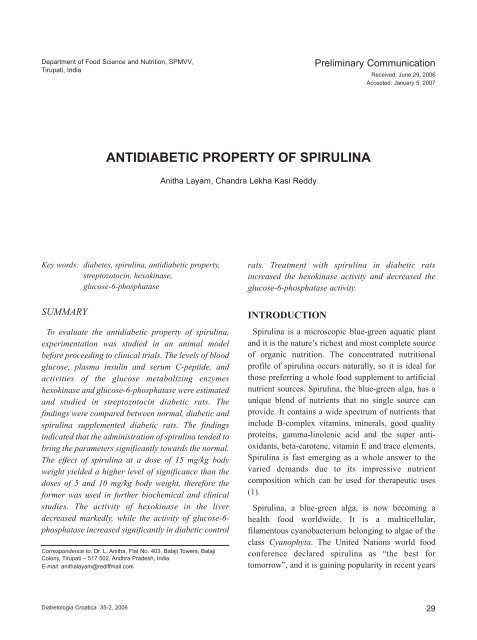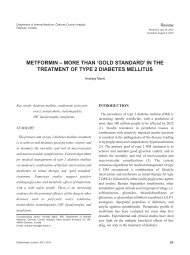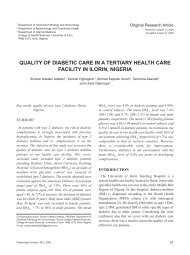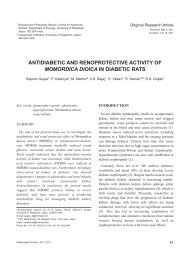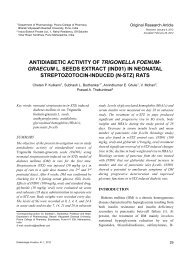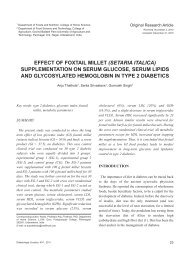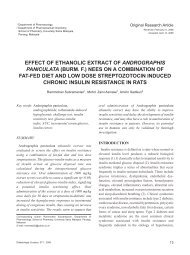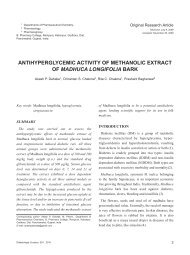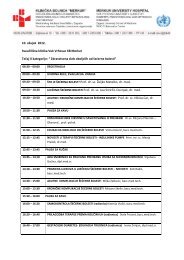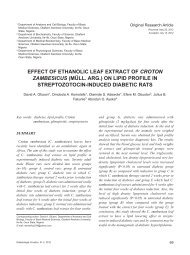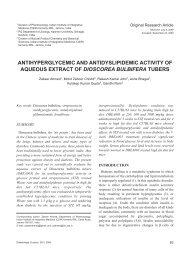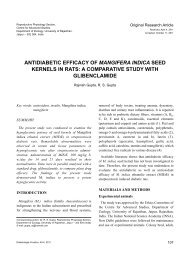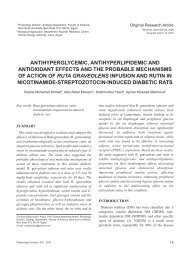ANTIDIABETIC PROPERTY OF SPIRULINA
ANTIDIABETIC PROPERTY OF SPIRULINA
ANTIDIABETIC PROPERTY OF SPIRULINA
You also want an ePaper? Increase the reach of your titles
YUMPU automatically turns print PDFs into web optimized ePapers that Google loves.
Department of Food Science and Nutrition, SPMVV,<br />
Tirupati, India<br />
Preliminary Communication<br />
Received: June 29, 2006<br />
Accepted: January 5, 2007<br />
<strong>ANTIDIABETIC</strong> <strong>PROPERTY</strong> <strong>OF</strong> <strong>SPIRULINA</strong><br />
Anitha Layam, Chandra Lekha Kasi Reddy<br />
Key words: diabetes, spirulina, antidiabetic property,<br />
streptozotocin, hexokinase,<br />
glucose-6-phosphatase<br />
SUMMARY<br />
To evaluate the antidiabetic property of spirulina,<br />
experimentation was studied in an animal model<br />
before proceeding to clinical trials. The levels of blood<br />
glucose, plasma insulin and serum C-peptide, and<br />
activities of the glucose metabolizing enzymes<br />
hexokinase and glucose-6-phosphatase were estimated<br />
and studied in streptozotocin diabetic rats. The<br />
findings were compared between normal, diabetic and<br />
spirulina supplemented diabetic rats. The findings<br />
indicated that the administration of spirulina tended to<br />
bring the parameters significantly towards the normal.<br />
The effect of spirulina at a dose of 15 mg/kg body<br />
weight yielded a higher level of significance than the<br />
doses of 5 and 10 mg/kg body weight, therefore the<br />
former was used in further biochemical and clinical<br />
studies. The activity of hexokinase in the liver<br />
decreased markedly, while the activity of glucose-6-<br />
phosphatase increased significantly in diabetic control<br />
Correspondence to: Dr. L. Anitha, Flat No. 403, Balaji Towers, Balaji<br />
Colony, Tirupati – 517 502, Andhra Pradesh, India<br />
E-mail: anithalayam@rediffmail.com<br />
rats. Treatment with spirulina in diabetic rats<br />
increased the hexokinase activity and decreased the<br />
glucose-6-phosphatase activity.<br />
INTRODUCTION<br />
Spirulina is a microscopic blue-green aquatic plant<br />
and it is the nature’s richest and most complete source<br />
of organic nutrition. The concentrated nutritional<br />
profile of spirulina occurs naturally, so it is ideal for<br />
those preferring a whole food supplement to artificial<br />
nutrient sources. Spirulina, the blue-green alga, has a<br />
unique blend of nutrients that no single source can<br />
provide. It contains a wide spectrum of nutrients that<br />
include B-complex vitamins, minerals, good quality<br />
proteins, gamma-linolenic acid and the super antioxidants,<br />
beta-carotene, vitamin E and trace elements.<br />
Spirulina is fast emerging as a whole answer to the<br />
varied demands due to its impressive nutrient<br />
composition which can be used for therapeutic uses<br />
(1).<br />
Spirulina, a blue-green alga, is now becoming a<br />
health food worldwide. It is a multicellular,<br />
filamentous cyanobacterium belonging to algae of the<br />
class Cyanophyta. The United Nations world food<br />
conference declared spirulina as “the best for<br />
tomorrow”, and it is gaining popularity in recent years<br />
Diabetologia Croatica 35-2, 2006<br />
29
A. Layam, C. L. K. Reddy / <strong>ANTIDIABETIC</strong> <strong>PROPERTY</strong> <strong>OF</strong> <strong>SPIRULINA</strong><br />
as a food supplement (2). The spirulina ability as a<br />
potent anti-viral (3-6), anti–cancer (7-11), hypocholesterolemic<br />
(12-17) and health improvement (18)<br />
agent is gaining attention as a nutraceutical and a<br />
source of potential pharmaceutical.<br />
Diabetes mellitus, a metabolic disorder, is becoming<br />
a major health problem. Although there are a number<br />
of drugs available on the market, long time use may<br />
cause a number of side effects. Hence, a large number<br />
of studies are in progress to find natural sources, which<br />
are effective in reducing the intensity of diabetes. The<br />
present study was undertaken to evaluate the<br />
antidiabetic effect of spirulina on streptozotocin<br />
induced (45 mg/kg body weight) diabetes in male<br />
albino Wistar rats. Blood glucose levels were elevated<br />
in diabetic rats. The levels of blood glucose, plasma<br />
insulin and serum C-peptide, and activities of the<br />
glucose metabolizing enzymes hexokinase and<br />
glucose-6-phosphatase were estimated using standard<br />
protocols. Oral administration of spirulina was carried<br />
out for 45 days. Findings are presented in tables.<br />
MATERIALS AND METHODS<br />
To demonstrate the antidiabetic property of spirulina<br />
and its effect on blood glucose levels, male albino<br />
Wistar rats aged seven to eight weeks (180-200 g)<br />
were used. A freshly prepared solution of<br />
streptozotocin (45 mg/kg i.p.) in 0.1 M citrate buffer,<br />
pH 4.5, was injected intraperitoneally. After 48 hours<br />
of streptozotocin administration, rats with moderate<br />
diabetes having glycosuria and hyperglycemia (i.e.<br />
with a blood glucose of 200-300 mg/dL) were taken<br />
for the experiment.<br />
In the experiment, a total of 36 rats (30 diabetic<br />
surviving rats and six normal rats) were used. The rats<br />
were divided into six groups of six rats each: group 1,<br />
normal untreated rats; group 2, diabetic control rats;<br />
group 3, diabetic rats given spirulina (5 mg/kg body<br />
weight); group 4, diabetic rats given spirulina (10<br />
mg/kg body weight); group 5, diabetic rats given<br />
spirulina (15 mg/kg body weight); and group 6,<br />
diabetic rats given glibenclamide (600 μg/kg body<br />
weight).<br />
The experimentation was carried out for 45 days,<br />
with oral administration of spirulina. At the end of 30<br />
days, the animals were deprived of food overnight and<br />
sacrificed by decapitation. Blood was collected in two<br />
different tubes, i.e. one with anticoagulant, potassium<br />
oxalate and sodium fluoride for plasma, and another<br />
without anticoagulant for serum separation. Serum<br />
was separated by centrifugation. Liver was<br />
immediately dissected, washed in ice cold saline,<br />
patted dry and weighed. Fasting blood glucose was<br />
estimated by the kit method. Plasma insulin level was<br />
assayed by the radio-immunoassay method. C-peptide<br />
level was assayed by the chemiluminescence<br />
immunoassay method. Hexokinase and glucose-6-<br />
phosphatase were assayed by standard protocols<br />
(19,20).<br />
RESULTS AND DISCUSSION<br />
Table 1 shows the levels of blood glucose, plasma<br />
insulin, C-peptide and total hemoglobin, and changes<br />
in body weight in normal and experimental rats. There<br />
was a significant increase in blood glucose levels,<br />
whereas plasma insulin, C-peptide and total<br />
Table 1. Blood glucose, plasma insulin, total hemoglobin, C-peptide and body weight in normal and experimental<br />
animals<br />
Fasting blood<br />
Body weight (g)<br />
glucose Plasma insulin C-peptide Hemoglobin<br />
No.<br />
Group<br />
Initial<br />
Final (mg/dL) (µ/mL) (ng/mL) (g/dL)<br />
1 Normal 196.33±7.42 203.67±3.55 92.67 a ±3.01 15.33 a ±0.81 1.5 a ±0.32 11.75 a ±0.52<br />
2 Diabetic control 197.67±10.48 158.5±4.63 232.33 b ±4.84 4.98 b ±0.50 0.50 b ±0.12 5.88 b ±0.38<br />
3 Diabetic + spirulina 5 mg/kg 192±2.85 197.17±11.89 220.8 b ±12.30 4.93 b ±0.30 0.73 b ±0.26 6.78 c ±0.49<br />
4 Diabetic + spirulina 10 mg/kg 196.5±13.12 209.67±6.65 159.5 c ±10.87 6.99 c ±0.43 1.10 c ±0.20 9.41 d ±0.86<br />
5 Diabetic + spirulina 15 mg/kg 202.67±12.97 213.5±8.57 114.0 a,d ±7.15 14.11 d ±0.44 1.42 d ±0.15 11.53 e ±0.70<br />
6<br />
Diabetic + glibenclamide<br />
600 µg/kg<br />
194.83±7.65 205.33±8.43 123.5 d ±7.42 12.78 e ±0.30 1.36 e ±0.33 10.29 d ±0.85<br />
Values not sharing a common superscript letter differ significantly at p
A. Layam, C. L. K. Reddy / <strong>ANTIDIABETIC</strong> <strong>PROPERTY</strong> <strong>OF</strong> <strong>SPIRULINA</strong><br />
hemoglobin levels decreased significantly in<br />
streptozotocin diabetic rats when compared with<br />
normal rats. The administration of spirulina and<br />
glibenclamide tended to bring the parameters<br />
significantly towards the normal. The effect of<br />
spirulina at a dose of 15 mg/kg body yielded a higher<br />
level of significance than the doses of 5 and 10 mg/kg<br />
body weight, therefore the former was used in further<br />
biochemical studies.<br />
Streptozotocin is well known for its selective<br />
pancreatic islet β-cell cytotoxicity and has been<br />
extensively used to induce diabetes mellitus in<br />
animals. It interferes with cellular metabolic oxidative<br />
mechanisms (21). Intraperitoneal administration of<br />
streptozotocin (45 mg/kg) effectively induced diabetes<br />
in normal rats, as reflected by glycosuria, hyperglycemia,<br />
polyphagia, polydipsia and body weight loss<br />
when compared with normal rats (22). In the present<br />
study, it was observed and demonstrated that oral<br />
administration of spirulina could reverse the above<br />
mentioned diabetic effects. The possible mechanism<br />
by which spirulina brings about its antihyperglycemic<br />
action may be through potentiation of the pancreatic<br />
secretion of insulin from islet β-cell or due to<br />
enhanced transport of blood glucose to the peripheral<br />
tissue. This was clearly demonstrated by the increased<br />
levels of insulin and C-peptide in diabetic rats treated<br />
with spirulina. In this context, a number of other<br />
products have also been reported to have an<br />
antihyperglycemic and insulin-release stimulatory<br />
effect (23,24).<br />
It is also evident from Table 1 that there was a<br />
decrease in total hemoglobin from normal to diabetic<br />
control albino rats, and this may be due to the<br />
formation of glycosylated hemoglobin. The increase<br />
in the level of hemoglobin in animals given spirulina<br />
may have been due to the decreased level of blood<br />
glucose, that would automatically lead to a decrease in<br />
glycosylated hemoglobin. Another reason might be<br />
that spirulina, which is a rich source of iron,<br />
contributed to the elevated levels of hemoglobin. The<br />
administration of spirulina to streptozotocin dosed<br />
animals reversed their weight loss. The ability of<br />
spirulina to recover body weight loss seems to be due<br />
to its antihyperglycemic effect.<br />
The activities of carbohydrate enzymes are presented<br />
in Table 2. The activity of hexokinase in liver<br />
decreased markedly, whereas the activity of glucose-6-<br />
phosphatase increased significantly in diabetic control<br />
rats. Treatment with spirulina in diabetic rats increased<br />
the hexokinase activity and decreased the glucose-6-<br />
phosphatase activity.<br />
Table 2. Changes in hexokinase and glucose-6-<br />
phosphatase activity in the liver of normal and experimental<br />
animals<br />
No. Group<br />
Hexokinase<br />
(units a /g<br />
protein)<br />
Glucose-6-<br />
phosphatase<br />
(units b /mg protein)<br />
1 Normal 148.76 ± 6.09 a 0.158 ± 0.012 a<br />
2 Diabetic control 109.68 ± 5.74 b 0.232 ± 0.013 b<br />
3 Diabetic + 130.72 ± 7.44 c 0.176 ± 0.010 a,c<br />
spirulina<br />
15 mg/kg<br />
4 Diabetic +<br />
glibenclamide<br />
600 µg/kg<br />
125.30 ± 6.30 c 0.190 ± 0.007 c<br />
Values not sharing a common superscript letter differ significantly at p
A. Layam, C. L. K. Reddy / <strong>ANTIDIABETIC</strong> <strong>PROPERTY</strong> <strong>OF</strong> <strong>SPIRULINA</strong><br />
(GSH/GSSG), which is coupled with conversion of<br />
NADPH to NADP (25). Spirulina may produce high<br />
NADP + , which results in down regulation of<br />
lipogenesis and lower risk of the tissues for oxidation<br />
stress and high resistance for diabetes.<br />
Accordingly, it can be concluded that spirulina has a<br />
beneficial effect on plasma insulin, C-peptide and<br />
hexokinase activity. Moreover, its antihyperglycemic<br />
effect in clinical trials (26-30) could represent a<br />
protective mechanism against the development of<br />
atherosclerosis and to maintain euglycemia.<br />
REFERENCES<br />
1. Venkataraman LV. Spirulina: global reach of a health<br />
care product. Souvenir, IFCON ‘98, 4 th International<br />
Food Convention, 1998;175.<br />
2. Kapoor R, Mehta U. Effect of supplementation of<br />
blue green algae on outcome of pregnancy of rats.<br />
Plants Food Hum Nutr 1993;43:131-148.<br />
3. Hayashi T, Hayashi K et al. Calcium spirulan, an<br />
inhibitor of enveloped virus replication, from a bluegreen<br />
alga Spirulina platensis. J Nat Prod<br />
1996;59:83-87.<br />
4. Hayashi K et al. An extract from Spirulina platensis<br />
is a selective inhibitor of herpes simplex virus type 1<br />
penetration into cells. Phytother Res 1993;7:76-80.<br />
5. Patterson RW. Antiviral activity of blue-green<br />
cultures. J Phycol 1993;29:125-130.<br />
6. Gustafson K et al. AIDS antiviral sulfolipids from<br />
cyanobacteria (blue-green algae). J Natl Cancer Inst<br />
1989;81:1254.<br />
7. Babu M et al. Evaluation of chemoprevention of oral<br />
cancer with Spirulina fusiformis. Nutr Cancer<br />
1995;24:197-202.<br />
8. Lisheng L et al. Inhibitive effect and mechanism of<br />
polysaccharide of Spirulina platensis on transplanted<br />
tumour cells in mice. Marine Sci 1991;5:33-38.<br />
9. Qishen P et al. Enhancement of endonuclease activity<br />
and repair DNA synthesis by polysaccharide of<br />
Spirulina platensis. Acta Genet Sinica (Chin J<br />
Genet) 1988;15:374-381.<br />
10. Schwartz J et al. Inhibition of experimental oral<br />
carcinogenesis by tropical beta carotene.<br />
Carcinogenesis 1986;7:711-715.<br />
11. Schwartz J, Shklar G et al. Prevention of<br />
experimental oral cancer by extracts of Spirulina –<br />
Duraliella algae. Nutr Cancer 1988;11:127-134.<br />
12. Nakaya N, Homma Y, Goto Y. Cholesterol lowering<br />
effect of spirulina. Nutr Rep Int 1988;37:1329-1337.<br />
13. Becker EW et al. Clinical and biochemical<br />
evaluations of spirulina with regard to its application<br />
in the treatment of obesity. Nutr Rep Int 1986;33:565.<br />
14. Kato T, Takemoto K, Katayama K, Kuwahara Y.<br />
Effect of Spirulina platensis to alimentary<br />
hypercholesterolemia in rat. Jpn Nat Food Assoc J<br />
1984;37:323.<br />
15. Koto T, Takemoto K. Effects of spirulina on hypercholesterolemia<br />
and fatty liver in rats. Food Assoc J<br />
1984;37:323.<br />
16. Iwate K, Inayama T, Kato T. Effects of Spirulina<br />
platensis on plasma lipoprotein lipase activity in<br />
fructose induced hyperlipidemia in rats. J Nutr Sci<br />
Vitaminol 1990;36:165-171.<br />
17. Devi MA, Venkataraman LV. Hypocholesterolemic<br />
effect of blue-green algae spirulina on albino rats.<br />
Nutr Rep Int 1983;28:519-530.<br />
18. Annapurna V, Shah N, Bhaskaran P, Bamji SM,<br />
Reddy V. Bioavailability of spirulina carotenes in<br />
preschool children. J Clin Biochem Nutr<br />
1991;10:145-151.<br />
19. Brandstrup N, Kirk JE, Bruni C. Determination of<br />
hexokinase in tissues. J Gerontol 1957;12:166-171.<br />
20. Koida H, Oda T. Pathological occurrence of glucose-<br />
6-phosphatase in liver disease. Clin Chim Acta<br />
1959;4:554-561.<br />
32
A. Layam, C. L. K. Reddy / <strong>ANTIDIABETIC</strong> <strong>PROPERTY</strong> <strong>OF</strong> <strong>SPIRULINA</strong><br />
21. Papaccio G, Pisanti FA, Latronico MV, Ammendola<br />
E, Galdieri M. Multiple low dose and single high<br />
dose treatments with streptozotocin do not generate<br />
nitric oxide. J Cell Biochem 2000;77:82-91.<br />
22. Calabresi P, Chabner BA. Antineoplastic agents. In:<br />
Goodman A, Rall JW, eds. The pharmacological basis<br />
of therapeutics, 8 th edition. New York: Pergamon<br />
Press; 1990.p.1209-1263.<br />
23. Pari L, Umamaheswari J. Hypoglycemic effect of<br />
Musa sapreitum, L. in alloxan induced diabetic rats. J<br />
Ethnopharmacol 1999;68:321-325.<br />
24. Prince PSM, Menon VP, Pari L. Hypoglycemic<br />
activity of Syzigium cumini seeds: effect on lipid<br />
peroxidation in alloxan diabetic rats. J<br />
Ethnopharmacol 1998;61:1-7.<br />
25. Bopanna KN, Kannan J, Sushma G, Balaraman R,<br />
Rathod SP. Antidiabetic and antihyperlipaemic<br />
effects of neem seed kernel powder on alloxan<br />
diabetic rabbits. Indian J Pharmacol 1997;29:162-<br />
167.<br />
27. Babu DY. Hypoglycaemic effects of algae spirulina<br />
in non-insulin dependent diabetes mellitus (NIDDM)<br />
patients. MS thesis. Bharathiar University,<br />
Coimbatore, 1989:1-70.<br />
28. Iyer U, Pariskh S. Glycemic index of spirulina<br />
supplemented recipes in NIDDM subjects. MS thesis.<br />
Department of Foods and Nutrition, Faculty of Home<br />
Science, M.S. University of Baroda, Baroda, 1996.<br />
29. Iyer U, Ahmedi S. Glycemic index of spirulina<br />
supplemented recipes. MS thesis. Department of<br />
Foods and Nutrition, Faculty of Home Science, M.S.<br />
University of Baroda, Baroda, 1997.<br />
30. Iyer U, Deshmukh S. Glycemic index of spirulina<br />
supplemented meals. MS thesis. Department of<br />
Foods and Nutrition, Faculty of Home Science, M.S.<br />
University of Baroda, Baroda, 1998.<br />
26. Anuradha V, Vidhya D. Impact of administration of<br />
spirulina on the blood glucose levels of selected<br />
diabetic patients. Indian J Nutr Dietet 2001;38:40-44.<br />
Diabetologia Croatica 35-2, 2006<br />
33


